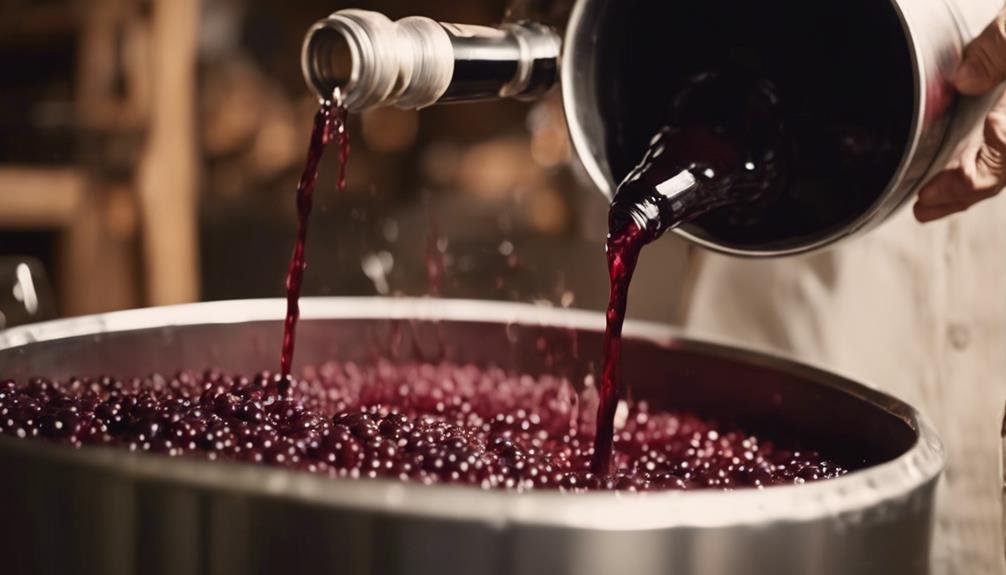Discover the secrets of oak in winemaking. French Oak species like Quercus robur and Quercus petraea are ideal for Pinot Noir, while American Oak contributes dill, coconut, and vanilla notes. Hungarian Oak offers an essential option. Oak enhances wine aromas and influences taste, crucial for complexity. Innovative oak barrel alternatives, such as oak staves and chips, are eco-friendly and economical. Oak treatments, like aging techniques and extracts, shape flavors—vanilla, coconut, spice—balancing the wine. Madeline Puckette, renowned for wine education, brings a fresh perspective. Unravel the mysteries of oak to appreciate the full spectrum of wine profiles.
Oak Species and Wine Preferences
The selection of oak species plays a pivotal role in determining the flavor profile and preferences of wines in the winemaking process. Winemaking traditions often dictate the choice between French Oak, American Oak, and Hungarian Oak.
French Oak, with species like Quercus robur and Quercus petraea, is favored for premium wines like Pinot Noir due to its fine-grained nature. American Oak, known for flavors like dill, coconut, and vanilla, adds ruggedness to fruit-forward wines. Hungarian Oak provides a more cost-effective alternative to French Oak, making it a popular choice among winemakers.
The oak aging techniques and flavor profiles associated with these different oak species profoundly impact the final taste and quality of wines, showcasing the importance of thoughtful oak selection in winemaking.
Impact of Oak on Aromas
Enhancing the aromatic profile of wine, oak plays a pivotal role in infusing distinct flavors and scents that contribute to the overall sensory experience.
Oak aging techniques, such as toasting levels and barrel size, influence the release of aroma compounds like vanillin, eugenol, and oak lactones.
Through sensory evaluation, winemakers can assess the impact of oak on wine complexity, noting how oak treatments impart spice, caramel, and smoky aromas.
The choice of oak species and origin further shapes the aromatic qualities of the wine, with French Oak favored for premium wines like Pinot Noir due to its delicate nuances.
Understanding the nuances of oak influence on aromas is essential in crafting wines that exhibit depth and character.
Oak Barrel Alternatives in Winemaking

Innovative solutions for oak barrel alternatives have revolutionized the winemaking industry, offering cost-effective and environmentally friendly options for aging wines. Oak infusion methods have become popular, with winemakers using oak staves, chips, and cubes as efficient alternatives to new oak barrels.
Bourbon producers, for instance, are required to age whiskey in new oak for a minimum of one year, showcasing the importance of oak in flavor development. These barrel alternatives are not only cheaper but also more sustainable, as traditional oak barrels can be used for up to 100 years before becoming neutral.
Embracing oak alternatives not only benefits winemakers economically but also helps in preserving oak forests for future generations.
Influence of Oak Treatments on Flavor
Oak treatments play a pivotal role in shaping the flavor profiles of wines, with their aromatic compounds and distinctive characteristics. Various oak aging techniques, such as the type of oak used, toasting levels, and aging duration, contribute to the sensory evaluation of wines.
Oak extract can impact the fermentation effects, influencing the development of flavors during the winemaking process. The choice of oak and how it is treated can introduce flavors like vanilla, coconut, and spice, as well as imparting texture and complexity to the wine.
Winemakers often rely on the sensory evaluation of oak-influenced wines to determine the ideal balance of flavors and aromas. Understanding the influence of oak treatments on flavor is essential for producing wines with unique and desirable characteristics.
Madeline Puckette and Wine Folly

Madeline Puckette, an accomplished James Beard Award-winning author and Wine Communicator of the Year, is recognized for her significant contributions to wine education through Wine Folly. Wine Folly, co-founded by Puckette, aims to make wine education accessible and fun for enthusiasts. Through platforms like @WineFolly, she provides valuable resources and updates on wine trends. Puckette's work helps individuals understand wine regions and food pairings, enhancing their overall wine knowledge. Below is a table highlighting some key aspects of Madeline Puckette and Wine Folly:
| Madeline Puckette | Wine Folly |
|---|---|
| James Beard Award-winning author | Provides valuable wine resources |
| Wine Communicator of the Year | Focuses on wine education and trends |
| Active on social media | Makes wine knowledge accessible |
| Aims for fun wine education | Updates on wine regions |
| Enhances understanding of food pairings | Valuable insights for wine enthusiasts |
Frequently Asked Questions
Can Oak Barrel Alternatives Completely Replicate the Flavors of Traditional Oak Barrels?
Oak barrel alternatives have made significant strides in replicating traditional oak barrel flavors. Through innovative techniques, sustainability is promoted by conserving oak forests. While not identical, these alternatives offer cost-effective solutions without compromising the essence of oak-aged wines.
How Do Different Oak Toasting Methods Affect the Final Aroma Compounds in Wine?
Different oak toasting methods notably impact aroma compounds in wine. Light toasting enhances fruity notes, while heavy toasting imparts smoky and spicy aromas. Oak aging also influences wine color depth and texture complexity.
What Is the Environmental Impact of Using Oak Barrel Alternatives in Winemaking?
In winemaking, utilizing oak barrel alternatives promotes sustainability practices by conserving oak forests. These alternatives aid in flavor extraction, providing cost-efficient and eco-friendly options. They allow for the desired oak influence while minimizing environmental impact, ensuring a balanced approach to winemaking.
Are There Specific Guidelines for the Reuse of Oak Barrels in Winemaking?
In winemaking, specific guidelines dictate oak barrel reuse. To maintain flavor consistency, barrels are inspected for integrity and cleaned thoroughly. Each use brings subtle flavor changes, necessitating replication precision to guarantee wine quality.
How Does Madeline Puckette Make Wine Education Entertaining and Accessible to Everyone?
Madeline Puckette engages audiences by offering informative and interactive wine education through engaging presentations and interactive workshops. Her approach makes complex wine topics accessible and enjoyable, cultivating a community of wine enthusiasts keen to learn and explore.
Conclusion
In the world of winemaking, oak plays a vital role in shaping the flavors and aromas of wines, adding complexity and depth to the final product.
From French to American to Hungarian oak, each type brings its unique characteristics to the aging process, influencing the wine's profile in subtle yet significant ways.
Understanding the secrets of oak in winemaking reveals a world of possibilities for creating exceptional wines that truly captivate the senses.